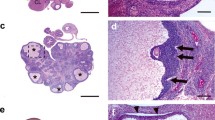Summary
Ethinyl estradiol (EE) in olive oil (0.02, 0.2, or 2.0 mg/kg) administered to pregnant mice on days 11 to 17 of pregnancy induced abnormal differentiation of gonocytes and fetal Sertoli cells in male fetuses on day 18 of gestation. Light and electron microscopic examination of the testes showed fewer darkly stained prospermatogonia and more lightly stained prospermatogonia in the experimental than in the control fetuses. Widespread degeneration and lysis of gonocytes were seen only in the experimental mice. No spermatogonia type A could be detected. In spite of comparable mitotic rates in the Sertoli cells of the experimental and control mice and more dark Sertoli cells with well developed smooth endoplasmic reticulum (SER) in the experimental mice, one of the functions of fetal Sertoli cells was suppressed: there were fewer dark slender Sertoli cells with long processes extending to the centers of tubules and more contact areas with gonocytes, phenomena which may play a role in the migration of gonocytes towards the periphery of the tubules. More Sertoli cells were detected in the undescended than the descended testes exposed to the highest dose of EE. These morphological findings indicate that prenatal exposure to EE induces acceleration of prespermatogenesis and disturbances in the initiation of spermatogenesis and in the mechanical function of Sertoli cells.
Similar content being viewed by others
References
Baillie AH (1964) The histochemistry and ultrastructure of the gonocyte. J Anat 98:641–645
Bibbo M, Gill W, Azizi F, Blough R, Fang CS, Rosenfield RL, Schumacher GFB, Sleeper K, Sonek MG, Wied G (1977) Follow-up study of male and femal offspring of DES-exposed mothers. Obstet Gynecol 49:1–8
Byskov AG (1978) Regulation of initiation of meiosis in fetal gonads. Int J Androl [Suppl] 2:29–38
Byskov AG, Saxén L (1976) Induction of meiosis in fetal mouse testis in vitro. Dev Biol 52:193–200
Chowdhury AK, Steinberger E (1975) Effect of 5-α-reduced androgen on sex accessory organs, initiation and maintenance of spermatogenesis in the rat. Biol Reprod 12:609–617
Driscoll SG, Taylor SH (1980) Effects of prenatal maternal estrogen on the male urogenital system. Obstet Gynecol 56:537–542
Dyche WJ (1975) Cytodifferentiation of the fetal mouse Sertoli cell. Anat Rec 181:349 (abstr)
Franchi LL, Mandl AM (1964) The ultrastructure of germ cells in foetal and neonatal male rats. J Embryol Exp Morphol 12:289–308
Gill WB, Schumacher GFB, Bibbo M (1977) Pathological semen and anatomical abnormalities of the genital tract in human male subjects exposed to diethylstilbestrol in utero. J Urol 117:477–480
Gondos B (1977) Testicular development. In: Johnson AD, Gomes WR (eds) The testis. Academic Press, New York San Francisco London, pp 1–37
Hilscher B, Hilscher W, Bülthoff-Ohnolz B, Krämer V, Birke A, Pelzer H, Gauss G (1974) Kinetics of gametogenesis. I. Comparative histological and autoradiographic studies of oocytes and transitional prospermatogonia during oogenesis and prespermatogenesis. Cell Tissue Res 154:443–470
Jost A, Magre S, Cressent M (1974) Sertoli cells and early testicular differentiation. In: Mancini RE, Martini L (eds) Male fertility and sterility. Academic Press, New York, pp 1–11
Kaplan CNM (1959) Male pseudohermaphrodism. Report of a case, with observations on pathogenesis. N Engl J Med 261:641–644
Kobayashi S (1984) Induction of Müllerian duct derivatives in testicular feminized (Tfm) mice by prenatal exposure to diethylstilbestrol. Anat Embryol 169:35–39
McLachlan JA (1981) Rodent models for perinatal exposure to diethylstilbestrol and their relation to human disease in the male. In: Herbst AL, Bern HA (eds) Developmental effect of diethylstilbestrol (DES) in pregnancy. Thieme-Stratton, New York; Thieme, Stuttgart New York, pp 148–157
McLachlan JA, Newbold RR, Bullok B (1975) Reproductive tract lesions in male mice exposed prenatally to diethylstilbestrol. Science 190:991–992
Nagano T, Suzuki F (1976) The postnatal development of the junctional complexes of the mouse Sertoli cells as revealed by freezefracture. Anat Rec 185:403–418
Nomura T, Kanzaki T (1977) Induction of urogenital anomalies and some tumors in the progeny of mice receiving diethylstilbestrol during pregnancy. Cancer Res 37:1099–1104
Roosen-Runge EC, Leik J (1968) Gonocyte degeneration in the postnatal male rat. Am J Anat 122:275–300
Spiegelman M, Bennett D (1973) A light- and electron-microscopic study of primordial germ cells in the early mouse embryo. J Embryol Exp Morphol 30:97–118
Steinberger E (1971) Hormonal control of mammalian spermatogenesis. Physiol Rev 51:1–17
Tran D, Josso N (1982) Localization of anti-Müllerian hormone in the rough endoplasmic reticulum of the developing bovine Sertoli cell using immunocytochemistry with a monoclonal antibody. Endocrinology 111:1562–1567
Wartenberg H (1978) Human testicular development and the role of the mesonephros in the origin of a dual Sertoli cell system. Andrologia 10:1–21
Wartenberg H (1981) Differentiation and development of the testes: In: Burger H, Krester D (eds) The testis. Raven Press, New York, pp 39–80
Yasuda Y (1981) The effect of prenatal exposure to ethinyl estradiol (EE) on the mouse fetal gonad. Teratology 24:24A (abstr)
Yasuda Y, Kihara T, Nishimura T (1981) Effects of ethinyl estradiol on development of mouse fetuses. Teratology 23:233–240
Yasuda Y, Kihara T, Tanimura T (1985a) Effect of ethinyl estradiol on the differentiation of mouse fetal testis. Teratology 32:113–118
Yasuda Y, Kihara T, Tanimura T, Nishimura H (1985b) Gonadal dysgenesis induced by prenatal exposure the ethinyl estradiol in mice. Teratology 32:219–227
Yasuda Y, Konishi H, Tanimura T (1986) Leydig cell hyperplasia in fetal mice treated transplacentally with ethinyl estradiol. Teratology 33
Zamboni L, Updadhyay S, Bézard J, Mauléon P (1981) The role of the mesonephros in the development of the sheep testis and its excurrent pathways. In: Byskov AG, Peter H (eds) Development and function of reproductive organs. Excerpta Medica, Amsterdam Oxford Princeton, pp 31–40
Author information
Authors and Affiliations
Additional information
Supported by a grant from Sankyo Foundation of Life Science
Rights and permissions
About this article
Cite this article
Yasuda, Y., Konishi, H., Matuso, T. et al. Accelerated differentiation in seminiferous tubules of fetal mice prenatally exposed to ethinyl estradiol. Anat Embryol 174, 289–299 (1986). https://doi.org/10.1007/BF00698779
Accepted:
Issue Date:
DOI: https://doi.org/10.1007/BF00698779




